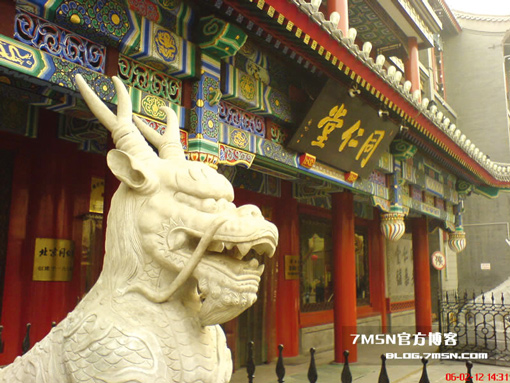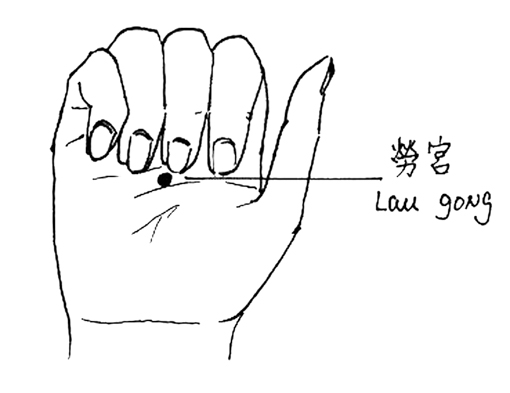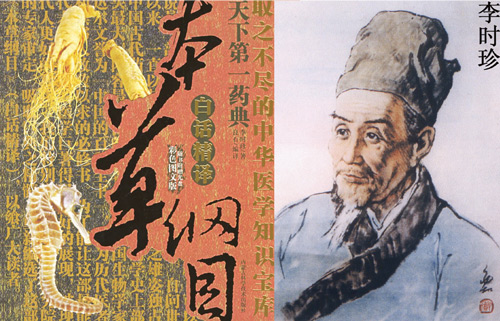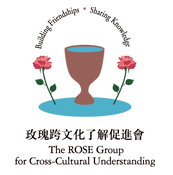Chinese Medicine
By Amy Tseng and Bruce J. Ballon
Traditional Chinese medicine has a 2000 to 3000- year history. Today, when seeking treatment for their medical ailments, many Chinese people still turn to traditional Chinese medicine. Like Western doctors, traditional Chinese doctors diagnose and treat patients; however, Chinese and Western methods for medical treatment differ, because they are based on different concepts of health. While Western medicine targets observable health problems with surgery and medication, traditional Chinese medicine balances non-observable energies within the body with food, herbs, and acupuncture.
 |
| Famous Chinese Medicine Store - Tong Rentang |
|
Westerners might wonder how Chinese doctors can detect so-called energies, which cannot be observed through modern diagnostic tools like microscopes, X-Rays, and scanning machines.The answer is that they detect energy imbalances in several steps:viewing a patient (examining the colors of his or her face, eyes, and tongue), listening to the patient's speech, cough, and breathing, smelling the patients’ body odors, asking the patient questions, and taking the patient’spulse.The ancient Chinese used the idea of a balanced universe to describe an ideally healthy person’s body.Within this universe, cold, cool, warm, and hot energies are perfectly balanced.An unbalanced universe is too cold or too hot, or is both too cold and too hot at the same time.By studying sick people, the Chinese created a classification system that grouped the non-observable imbalances that cause the observable illnesses into hot and cold categories.They also defined the looks, sounds, smells, behaviors, and pulse patterns that were common among patients suffering the imbalances so that Chinese doctors could learn how to diagnose them.
 |
| Acupuncture can reduce pain and relax the nervous system. For example, this diagram depicts the acupuncture point called lau gong. Before stressful situations like exams and interviews, you can use the thumb on the other hand to press this point to calm your nervous system. |
|
The idea of unobservable energy imbalances may seem puzzling to those learning about Chinese medicine for the first time.Furthermore, it is not clear how “balancing energies” can solve medical problems calling for surgery like appendicitis or eye cataracts. For the ancient Chinese, energy is the life force that flows throughout the body (or “universe” through invisible channels.) These channels can be compared to highways and roads, through which energy, like traffic, can flow poorly or well.Acupuncture points mark the intersections for a person’s energy channels.When similar to a traffic jam, there is an energy blockage along these channels, a patient experiences hot and/or cold imbalances.
Upon detecting these blockages, traditional Chinese doctors use food, herbs, and acupuncture needles to improve the poor energy flow, which is the root of chronic medical conditions, rather than only the symptoms.Before giving patients acupuncture, Chinese doctors will first try to use the hot and cold energy properties in food and herbs to correct their patients’ imbalances.For example, they will prescribe a diet of warm foods and herbs to correct either cold or hot imbalances.If diet and herbs alone cannot adequately improve a patient’s condition, Chinese doctors will provide acupuncture to the patient to stimulate energy flow.Acupuncture needles, inserted into acupuncture points that are located in channels relevant to the patient’s health problems, act like traffic cops that open blockages disrupting energy flows.Often, multiple treatments are necessary to clear the blocks.
 |
| Chinese Doctor Li Shizhen and his book Ben Cao Gang Mu about Chinese medicine was used for over 500 years. |
|
By correcting imbalances, Chinese medicine attempts to prevent illnesses that require surgery. Western research has proven that acupuncture effectively treats physical ailments like muscle pain in both humans and animals. Many Western doctors have incorporated acupuncture into their treatments of patients. Therefore, traditional Chinese healing methods can complement Western surgical procedures.
Since Chinese medicine concentrates on prevention, Chinese doctors recommend that patients follow a lifestyle that can reduce their chances of suffering hot and cold imbalances.To promote health, individuals should try to sleep before midnight and rise early.Other activities that help to keep bodies in balance include reducing stress through meditation, practicing martial arts (like taiji 太极 ) to improve circulation, and drinking green tea to boost the immune system.Traditional Chinese doctors also recommend that their patients avoid processed foods and eat foods rich in fiber, vitamins, and low-fat proteins.Examples of such foods are brown rice, green leafy vegetables, and tofu. These foods are consistent with diets that Western nutritionists consider healthy.
Amy Tseng Ballon is trained in Traditional Chinese Medicine. She has been practicing in North America and Europe for many years. Bruce J. Ballon, MD is an ophthalmologist who traveled to Taiwan and studied Chinese medicine 29 years ago. He married Amy and follows the Chinese medicine principles of balance in life. |
|



